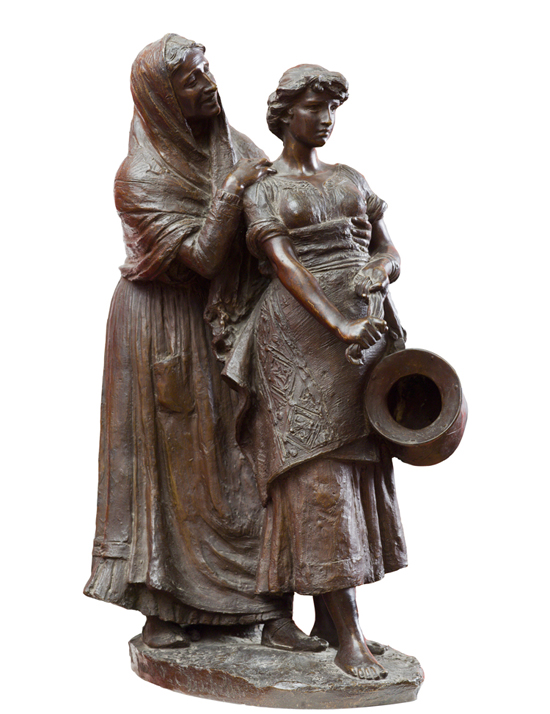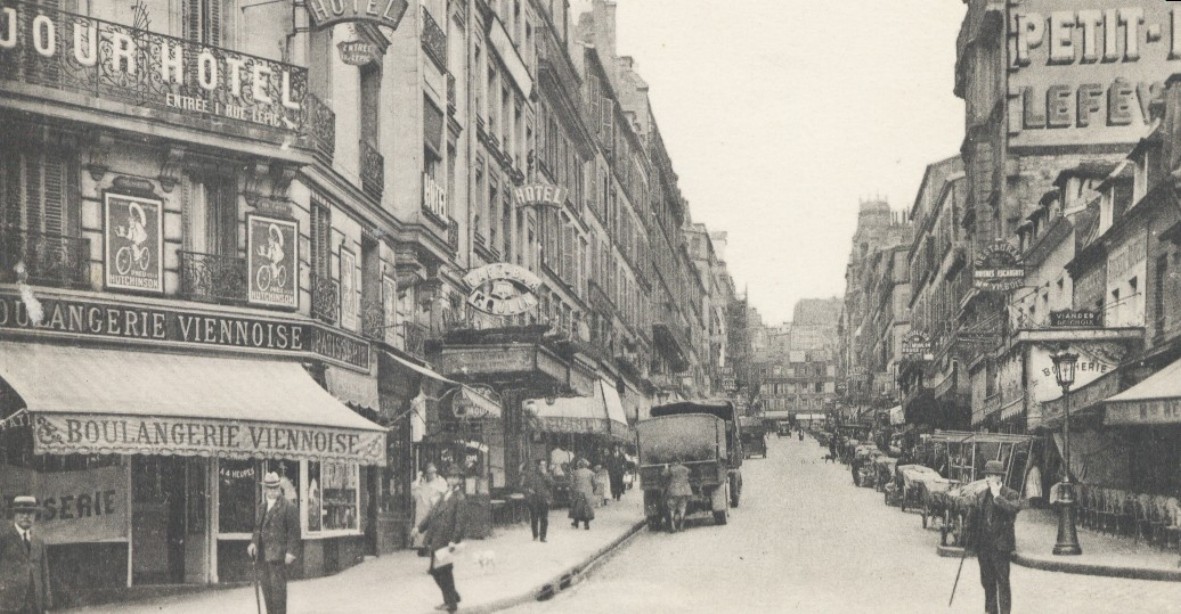|
Costantino Barbella
Costantino Barbella (January 31, 1853, in Chieti – December 5, 1925) was an Italian sculptor, known as ''il Michetti della scultura''. He began his career by modeling terracotta figurines for churches and Nativity Scenes (Presepe). In 1872, Francesco Paolo Michetti encouraged him to use stipend from the province to study at the Istituto di Belle Arti in Naples. He studied there with Stanislao Lista. He was highly prolific in creating small terracotta and bronze statuary, much of it depicting country folk dancing or in animated movement. He also made a few portraits, including of Pope Leo XIII. His work was exhibited throughout Europe, commonly winning awards. He was named cavaliere dell' Order of Leopold II of Belgium, honorary professor of the Istituto Reale di Belle Arti in Naples, and honorary academician at the Istituto di Belle Arti di Bologna. Among his students was Argentinian sculptor Lola Mora.Encyclopedia of Contemporary Latin American and Caribbean Cultures, edited ... [...More Info...] [...Related Items...] OR: [Wikipedia] [Google] [Baidu] |
Chieti
Chieti (, ; , , ; ) is a city and ''comune'' (municipality) in Southern Italy, east of Rome. It is the capital of the province of Chieti, in the Abruzzo, Abruzzo region. In Italian, the adjectival form is ''teatino'' and inhabitants of Chieti are called "''teatini''". The English form of this name is preserved in that of the Theatines, a Catholic religious order. History Mythological origins and etymology Chieti is among the most ancient of Italian cities. According to mythological legends, the city was founded by the fellows of Achilles and was named in honor of his mother, Thetis. Other traditions attribute the foundation to Ancient Greece, Greeks after the destruction of Troy, to Hercules or a queen of Pelasgians. According to Strabo, it was founded by the Arcadia (ancient region), Arcadians as Thegeate (Θηγεάτη), named after Tegea. It was called Theate () (or Teate in Latin). As Theate Marrucinorum, Chieti was the chief town of the warlike Marrucini. First prehi ... [...More Info...] [...Related Items...] OR: [Wikipedia] [Google] [Baidu] |
1853 Births
Events January–March * January 6 – ** Florida Governor Thomas Brown signs legislation that provides public support for the new East Florida Seminary, leading to the establishment of the University of Florida. **U.S. President-elect Franklin Pierce's only living child, Benjamin "Benny" Pierce, is killed in a train accident. * January 8 – Taiping Rebellion: Zeng Guofan is ordered to assist the governor of Hunan in organizing a militia force to search for local bandits. * January 12 – Taiping Rebellion: The Taiping army occupies Wuchang. * January 19 – Giuseppe Verdi's opera '' Il Trovatore'' premieres in performance at Teatro Apollo in Rome. * February 10 – Taiping Rebellion: Taiping forces assemble at Hanyang, Hankou, and Wuchang, for the march on Nanjing. * February 12 – The city of Puerto Montt is founded in the Reloncaví Sound, Chile. * February 22 – Washington University in St. Louis is founded as Eliot Seminary. * March 5 – Saint Paul Fire ... [...More Info...] [...Related Items...] OR: [Wikipedia] [Google] [Baidu] |
Italian Male Sculptors
Italian(s) may refer to: * Anything of, from, or related to the people of Italy over the centuries ** Italians, a Romance ethnic group related to or simply a citizen of the Italian Republic or Italian Kingdom ** Italian language, a Romance language *** Regional Italian, regional variants of the Italian language ** Languages of Italy, languages and dialects spoken in Italy ** Italian culture, cultural features of Italy ** Italian cuisine, traditional foods ** Folklore of Italy, the folklore and urban legends of Italy ** Mythology of Italy, traditional religion and beliefs Other uses * Italian dressing, a vinaigrette-type salad dressing or marination * Italian or Italian-A, alternative names for the Ping-Pong virus, an extinct computer virus * ''Italien'' (magazine), pro-Fascist magazine in Germany between 1927 and 1944 See also * * * Italia (other) * Italic (other) * Italo (other) * The Italian (other) The Italian may refer to: * ''The Itali ... [...More Info...] [...Related Items...] OR: [Wikipedia] [Google] [Baidu] |
19th-century Italian Sculptors
The 19th century began on 1 January 1801 (represented by the Roman numerals MDCCCI), and ended on 31 December 1900 (MCM). It was the 9th century of the 2nd millennium. It was characterized by vast social upheaval. Slavery was Abolitionism, abolished in much of Europe and the Americas. The First Industrial Revolution, though it began in the late 18th century, expanded beyond its British homeland for the first time during the 19th century, particularly remaking the economies and societies of the Low Countries, France, the Rhineland, Northern Italy, and the Northeastern United States. A few decades later, the Second Industrial Revolution led to ever more massive urbanization and much higher levels of productivity, profit, and prosperity, a pattern that continued into the 20th century. The Catholic Church, in response to the growing influence and power of modernism, secularism and materialism, formed the First Vatican Council in the late 19th century to deal with such problems an ... [...More Info...] [...Related Items...] OR: [Wikipedia] [Google] [Baidu] |
People From Chieti
The term "the people" refers to the public or common mass of people of a polity. As such it is a concept of human rights law, international law as well as constitutional law, particularly used for claims of popular sovereignty. In contrast, a people is any plurality of persons considered as a whole. Used in politics and law, the term "a people" refers to the collective or community of an ethnic group or nation. Concepts Legal Chapter One, Article One of the Charter of the United Nations states that "peoples" have the right to self-determination. Though the mere status as peoples and the right to self-determination, as for example in the case of Indigenous peoples (''peoples'', as in all groups of indigenous people, not merely all indigenous persons as in ''indigenous people''), does not automatically provide for independent sovereignty and therefore secession. Indeed, judge Ivor Jennings identified the inherent problems in the right of "peoples" to self-determination, as i ... [...More Info...] [...Related Items...] OR: [Wikipedia] [Google] [Baidu] |
1925 Deaths
Events January * January 1 – The Syrian Federation is officially dissolved, the State of Aleppo and the State of Damascus having been replaced by the State of Syria (1925–1930), State of Syria. * January 3 – Benito Mussolini makes a pivotal speech in the Italian Chamber of Deputies (Italy), Chamber of Deputies which will be regarded by historians as the beginning of his dictatorship. * January 5 – Nellie Tayloe Ross becomes the first female governor (Wyoming) in the United States. Twelve days later, Ma Ferguson becomes first female governor of Texas. * January 25 – Hjalmar Branting resigns as Prime Minister of Sweden because of ill health, and is replaced by the minister of trade, Rickard Sandler. * January 27–February 1 – The 1925 serum run to Nome (the "Great Race of Mercy") relays diphtheria antitoxin by dog sled across the U.S. Territory of Alaska to combat an epidemic. February * February 25 – Art Gillham records (for Columbia Re ... [...More Info...] [...Related Items...] OR: [Wikipedia] [Google] [Baidu] |
Lola Mora
Dolores Candelaria Mora Vega (17 November 1866 – 7 June 1936), known professionally as Lola Mora, was an Argentine sculptor. She is known today as a cultural rebel and a pioneer of women in her artistic field. Early life left, 150px, Mora in the 1890s Dolores was the daughter of Romualdo Alejandro Mora, a prosperous landowner of Tucumán Province of Spanish origin and Regina Vega. She was the third born of seven children, three boys and four girls. Her parents decided that the girls should also have the best education possible (unusual behavior for the time). In 1870, her parents moved the family to San Miguel del Tucumán when Lola was four years old. At seven years of age, she was a boarding school pupil at Colegio Sarmiento de Tucumán Province. In 1885, both her parents died within two days. Her older sister Paula Mora Vega married the engineer Guillermo Rucker, and together took care of the orphans. Education At 20 years of age she began painting portraits, but soon t ... [...More Info...] [...Related Items...] OR: [Wikipedia] [Google] [Baidu] |
Kingdom Of The Two Sicilies
The Kingdom of the Two Sicilies () was a kingdom in Southern Italy from 1816 to 1861 under the control of the House of Bourbon-Two Sicilies, a cadet branch of the House of Bourbon, Bourbons. The kingdom was the largest sovereign state by population and land area in Italy before the Italian unification, comprising Sicily and most of the area of today's ''Mezzogiorno'' (southern Italy) and covering all of the Italian peninsula south of the Papal States. The kingdom was formed when the Kingdom of Sicily merged with the Kingdom of Naples, which was officially also known as the Kingdom of Sicily. Since both kingdoms were named Sicily, they were collectively known as the "Two Sicilies" (''Utraque Sicilia'', literally "both Sicilies"), and the unified kingdom adopted this name. The king of the Two Sicilies was Expedition of the Thousand, overthrown by Giuseppe Garibaldi in 1860, after which the people voted in a plebiscite to join the Kingdom of Sardinia (1720–1861), Kingdom of Sardi ... [...More Info...] [...Related Items...] OR: [Wikipedia] [Google] [Baidu] |
Accademia Di Belle Arti Di Napoli
The Accademia di Belle Arti di Napoli (Naples Academy of Fine Arts) is a university-level art school in Naples. In the past it has been known as the Reale Istituto di Belle Arti and the Reale Accademia di Belle Arti. Founded by King Charles VII of Naples in 1752, it is one of the oldest art schools in Italy, and offers various levels of study up to and including the equivalent of an Italian laurea (the country's main post-secondary academic degree). It is located one block south of the church of Santa Maria di Costantinopoli, on the via of the latter church's name. History The academy was founded in 1752 by Charles VII of Naples and had its origins in two schools, the Accademia del Disegno (Academy of Drawing) and the Accademia del Nudo (Academy of the Nude). It was originally housed in buildings attached to the church of San Carlo alle Mortelle. For many years its administration remained under the control of the Reale Laboratorio delle Pietre Dure (Royal Gemstone Laboratory) ... [...More Info...] [...Related Items...] OR: [Wikipedia] [Google] [Baidu] |
Leo XIII
Pope Leo XIII (; born Gioacchino Vincenzo Raffaele Luigi Pecci; 2March 181020July 1903) was head of the Catholic Church from 20 February 1878 until his death in July 1903. He had the fourth-longest reign of any pope, behind those of Peter the Apostle, Pius IX (his immediate predecessor), and John Paul II. Born in Carpineto Romano, near Rome, Leo XIII is well known for his intellectualism and his attempts to define the position of the Catholic Church with regard to modern thinking. In his 1891 encyclical ''Rerum novarum'', Pope Leo outlined the rights of workers to a fair wage, safe working conditions, and the formation of trade unions, while affirming the rights to property and free enterprise, opposing both atheistic socialism and ''laissez-faire'' capitalism. With that encyclical, he became popularly called the "Social Pope" and the "Pope of the Workers", also having created the foundations for modern thinking in the social doctrines of the Catholic Church, influencing his ... [...More Info...] [...Related Items...] OR: [Wikipedia] [Google] [Baidu] |








